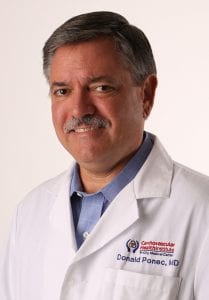 DONALD J. PONEC M.D.
DONALD J. PONEC M.D.
INTERVENTIONAL RADIOLOGY
TRI-CITY MEDICAL CENTER
Atrial Fibrillation ( “A-fib”) is an abnormality of the heart rhythm that affects over 3 million adults in the United States.
The likelihood of developing A-fib increases with age and is somewhat more common in men than women. In A-fib the atria (or upper chambers of the heart) do not contract properly due to an abnormality in the electrical activity of the heart muscle. This results in disorganized heartbeats that reduce the efficiency and output of the heart and can allow blood clots to form. The blood clots increase the risk of having a stroke.
THERE ARE TWO TYPES OF A-FIB (BOTH CAN CAUSE COMPLICATIONS):
- Paroxysmal (intermittent) A-fib that comes and goes
- Persistent A-fib which lasts longer than a week.
THERE ARE MANY POTENTIAL CAUSES OF A-FIB:
- Age over 65

- High blood pressure
- Heart attack (called “Myocardial Infarction” or “MI”)
- Heart valve abnormalities
- Alcohol consumption
- Sleep apnea
- Certain medical conditions including diabetes, obesity, kidney or thyroid conditions
- Certain medications, especially asthma or COPD medications
A-fib can cause a feeling of chest discomfort or pain, a feeling of palpitation or heart racing, lightheaded or dizzy feeling, shortness of breath, fainting or severe fatigue. The severity of symptoms can vary, and some people may have no symptoms at all. It is important to detect A-fib as there are a number of medications and other treatments available to reduce the risk of complications (such as heart failure, certain types of dementia and premature death). Many patients with A-fib are treated with blood thinners (anticoagulants) to reduce the risk of blood clots. A-fib is diagnosed by ECG (electrocardiogram) testing, and by physical examination by your doctor. The best treatment depends on each patient’s individual situation, history and other conditions.
A dreaded complication of A-fib is stroke caused by a blood clot (called an embolus) that is ejected from the heart and lodges in one of the blood vessels that supply the brain. This can lead to permanent brain damage and disability.
Signs and symptoms of stroke include sudden onset of facial droop, arm or leg weakness or difficulty speaking or understanding words. It is crucial to call “911” immediately in the event that stroke is suspected. It is said that “Time is Brain,” meaning that the more quickly stroke is recognized and treated, the better the chances of recovery. There are new treatments for stroke that in many cases result in substantial improvement and even complete recovery. These include giving a clot-dissolving medicine called tPA, and a newer treatment called “Thrombectomy”. Thrombectomy is a minimally invasive procedure performed in Interventional Radiology, where a tiny catheter is passed from the leg into the blocked blood vessel in the brain. The clot can then be removed and blood flow restored, significantly improving recovery from stroke
Tri-City Medical Center is a Joint Commission Certified Thrombectomy Capable Stroke Center (one of only 36 such centers in the United States), as well as a center of excellence for the treatment of A-fib and other heart problems. You can count on Tri-City Medical Center to help you stay healthy
ABOUT THE AUTHOR
Dr. Ponec serves as Director of Interventional Radiology and Department Chair at Tri-City Medical Center.
